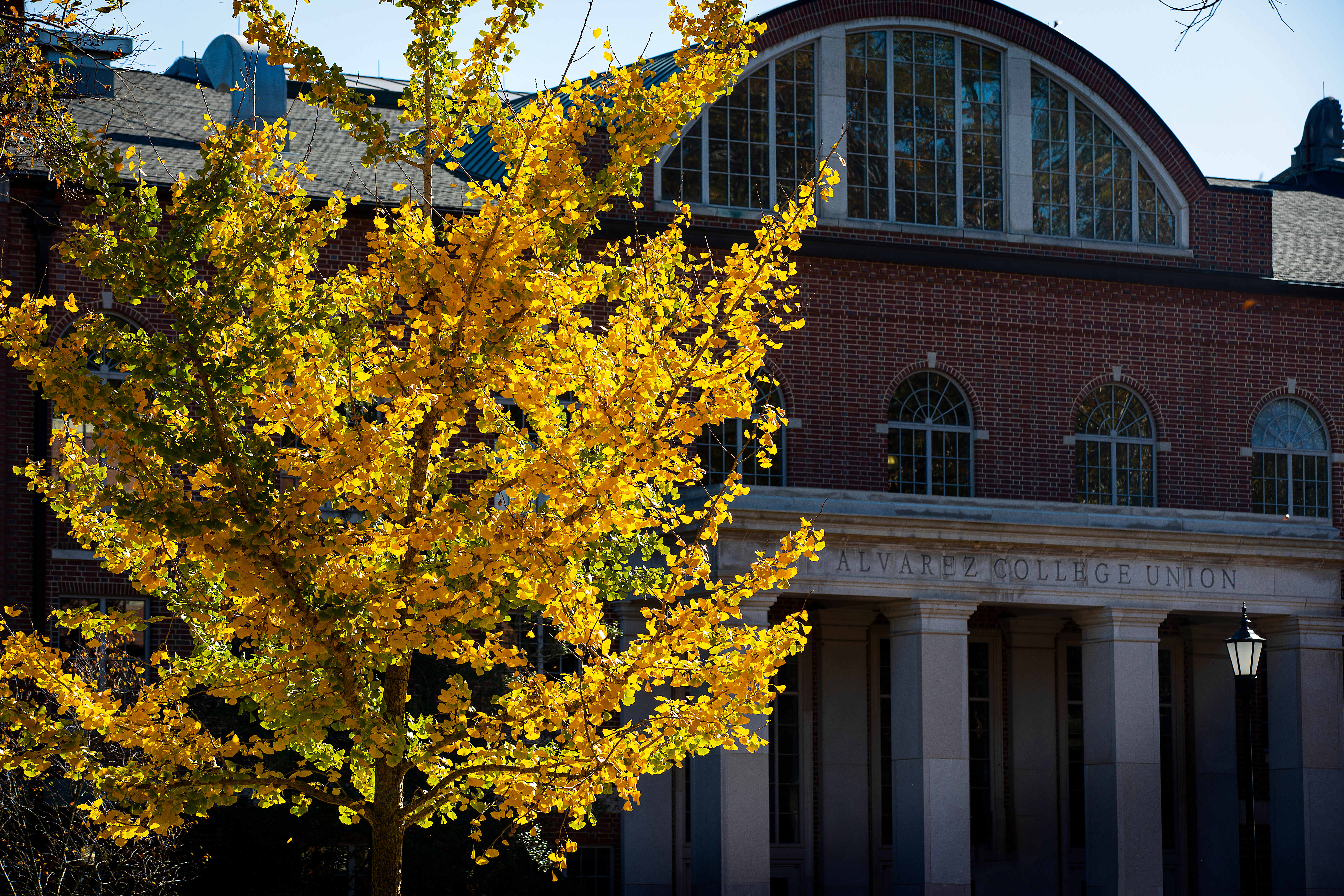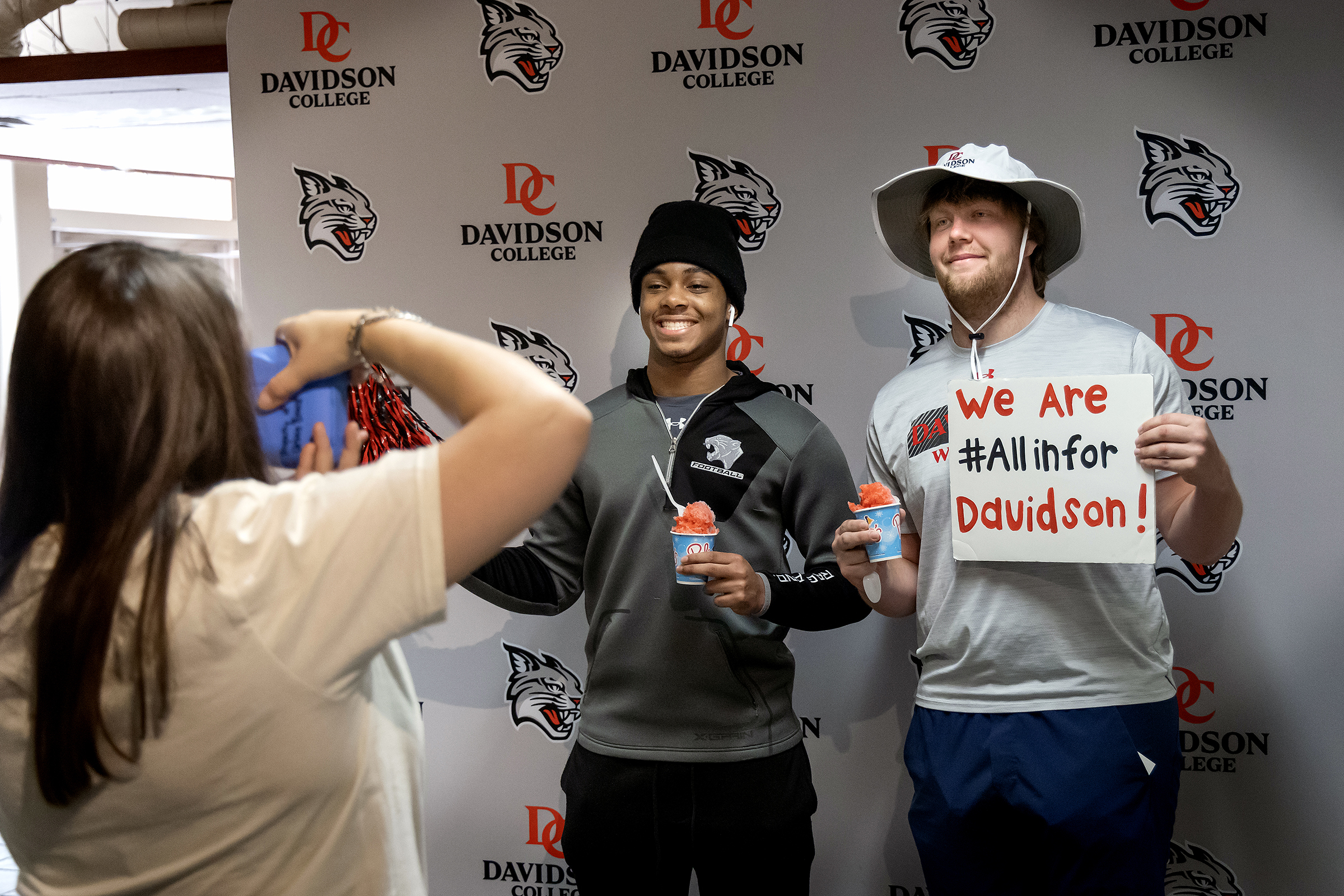Students Sift Through History, Unearth Rare Finds for Iwo Jima Filmmaker
April 26, 2021
- Author
- Mark Johnson

Gabe Jones '24 and Charlotte Jenkins '22
As Gabe Jones dug through decades of electronic photo and video files from the Nippon News Agency, his eyes latched on to an old film reel.
The listing for the 76-year-old reel gave the amateur digital archeologist pause: the film had been watched only a few dozen times, and it was not in English.
“You don’t know until you find it,” said Jones, a first year Davidson College biology major and football player from Tampa. “I thought, ‘This is the gem.’”
The newsreel offered rare glimpses and interviews with Japanese soldiers preparing to defend the island of Iwo Jima in 1945—diving under tanks in training exercises or offering thoughts in the pre-conflagration calm.
“It was stuff we had not discovered,” said documentary filmmaker Tim Gray, who had partnered with Jones and the rest of Davidson History Professor John Wertheimer’s class on World War II for research on Iwo Jima.
Their assignment? Find what hasn’t been found.
Tom Selleck and Bob McKillop
Gray has produced nearly 30 documentaries about World War II featuring celebrity narrators, such as Hollywood’s Gary Sinise and Tom Selleck, New England Patriots Coach Bill Belichick and country singer Luke Bryan. Gray also runs the World War II Foundation out of his home state of Rhode Island. Davidson College caught his eye in 2018 when Men’s Head Basketball Coach Bob McKillop took his team to the USS Arizona Memorial, at Pearl Harbor, during a tournament in Hawaii.
Gray, a graduate of rival University of Rhode Island, traded emails with McKillop and introduced himself when the Wildcats later played at Rhode Island. Gray talked about wanting to work on a project with a college or university, and McKillop knew Wertheimer had started experimenting with documentaries.
“I said, ‘How about this idea of working with the Davidson History Department,” McKillop recalled.
Wertheimer first offered his “Filming Southern History” class three years ago. He team teaches with filmmakers who cover the technical parts of the projects. So when McKillop raised the idea of working with Gray, it didn’t seem like an unfamiliar world.
“It’s conveying historical knowledge in another way,” Wertheimer said, “to a different public.”
Some of Gray’s documentaries focus on individual battles, and Iwo Jima has long been on his list. The battle in the war’s final months proved pivotal to Allied success in the Pacific. Japanese fighters based at Iwo Jima posed a formidable obstacle to Allied bombing raids on Japan.
“The B-29s, our biggest planes…were being shot down by Japanese planes flying out of Iwo Jima,” said Sam Maloney, a 1948 graduate of Davidson and former chair of the Religion Department, who flew B-24 bomber missions out of Okinawa at the same time.
Capturing the island proved more costly for the United States than expected. American forces bogged down in soft, black volcanic ash on the beach, and Japanese forces burrowed into fortified bunkers and an 11-mile network of tunnels in the mountains.
The American victory, after five weeks instead of the expected few days, created what may be Americans’ most familiar war image: six U.S. Marines planting their nation’s flag on Mount Suribachi. The flag-raising and the battle spurred images for postage stamps, the name of a U.S. Navy ship, the statue at the Marine Corps memorial near Washington, D.C., a film starring John Wayne and two directed by Clint Eastwood—one from the perspective of each side.
Digging
The familiarity of the battle made the project more challenging. Wertheimer assigned students to review sections of a new collection of film clips shot by combat cameramen during and around the Battle of Iwo Jima, and held by the University of South Carolina Library. He also asked the class to ferret out other sources, find elements that brought new insights to the project.
“There must be thousands of videos and pieces of content online about Iwo Jima,” said Wes Clark, a first-year student from Berwyn, Pennsylvania, near Philadelphia, interested in documentary filmmaking as a possible career path. “You have to tell it through a viewpoint that hasn’t been told before.”
One of Wertheimer’s aims was for students to learn to do research.
“It’s not prepackaged,” he said. “They found stories in the archives that spoke to them. I’m not sure that conventional research projects, conventional teaching in general, gets students to that place frequently…They’re usually in a more passive position: consume the information, process it, synthesize it. We’re asking students to go out and be creators, to dig up things they didn’t know of before and analyze the significance of it for an audience.”
For the students, it was a project that would live beyond their class, beyond Davidson and would help teach others.
The newsreel Jones uncovered included Japanese soldiers predicting that none of them would return home.
Clark found in the University of South Carolina collection a scratched, rarely seen film of American soldiers burying one of their own on Iwo Jima during or immediately after the battle. The procession passes a line of crosses marking other graves and ends with two soldiers kneeling at a cross, sobbing.
It was not back home and amid the support of family that they laid their brothers-in-arms to rest, but on the battlefield. Clark described it as “adding another layer” to the story.
“These two gentlemen crying by their friend’s grave,” Clark said, “are not significantly older than me.”
Charlotte Jenkins, a third-year Davidson student from Montclair, New Jersey, came across a now-obscure song recorded by Johnny Cash in 1964 about Ira Hayes, a Pima Native American who was among the flag raisers in the famous Iwo Jima photo. The ballad captures his trials after the war with post-traumatic stress disorder and alcoholism. He died in 1955, near his home in Arizona, of alcohol poisoning and exposure to the cold.
“His story is representative of both the heroism in World War II and the inability to cope with reality after the war, coming back to a world where it wasn’t like that anymore,” Jenkins said. “Even though we can’t relate to the physical experiences of warfare, there’s an emotional unity. These were people our age who were thrown into this unimaginable experience.”
The students brought these pieces to Gray, along with reflections of other rarely heard perspectives. They tapped material in the National Archives never before used.
“Their enthusiasm for the whole project was off the charts,” Gray said. “They each brought something different.”
He plans to film on Iwo Jima in September, as Japan permits visitors only once a year, and release the completed film next year. Wertheimer’s students will be watching…and in the credits.



